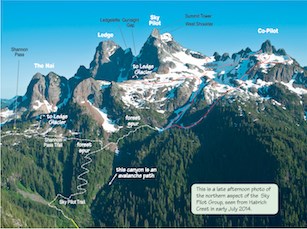It's finally happened.
The long awaited new climbing guidebook, Â鶹Éç¹ú²úRockclimbs, from local prolific author and climbing custodian Kevin McLane has finally been published. His partner in this project, Andrew Boyd, is one of Squamish's most undercover talents. From cold sweat-producing aid leads to visionary free climbing, Boyd helped usher in the new era of harder and often bolder traditional climbing, beginning in the early 2000s. Why are these two the perfect pair for authoring the latest and most current edition of Squamish's climbing record?
It's a little like locking DNA in amber for eternity.
I began climbing in 1994, lulled out of curiosity and a best pal's convincing words, to the drab grey walls of The Rockhouse climbing gym, once located in Richmond B.C. We listened to Utah Saints techno and tried to get the hang of stiff climbing shoes.
Flash to the summer of that year, me tying into my first climbing rope and lacing up my Boreal Aces. I still remember the print and feel of that rope and the feeling of the canvas lining in the shoes on my sweaty feet. I also remember my first guidebook.
The Rockclimbers' Guide to Squamish, written by none other than Kevin McLane accompanied me to my summer job, where on lunch breaks I would sit, hazily flipping through page after page of dreams for the taking, the summer sun baking me as I forgot to return to work. Sweat dripped down my nose as I snapped the volume shut and raced back to the job. In many ways, this set the tone for how climbing fit or did not fit with the necessities of my life. I still own that first of my guides to Â鶹Éç¹ú²úrock climbing and can still recall lines from route descriptions and the photos within, which created great context for my growing interest in climbing.
The new, advertising-free guidebook chronicles more than 2,000 routes including at Murrin, the Stawamus Chief, and the Smoke Bluffs.Ìý It also includes the alpine peaks of Sky Pilot and the sea cliffs of Howe Sound as well as 76 pages on the history of climbing in Squamish.
I was curious whether the authors saw their duty as historical recorders for a community or as a compiler of popular climbing information, which could draw as many people as possible to the area.Ìý
"To give climbers a complete, accurate, enduring portrait of the crags and climbs of Squamish," McLane said.Ìý "A good complete reference guide is the climbing community's historical bedrock, the ground that portrays the living record of the climbs and the people who created them."
According to McLane, his new guide records over 100 years of human effort in the area.
I also wondered why the authors had chosen now as the right time for this new guide.
"It's been 13 years since the last complete reference guide to Â鶹Éç¹ú²úwas published, so it was time," McLane said matter-of-factly.
He's right.
Â鶹Éç¹ú²úhas grown into one of the biggest and most popular climbing destinations in North America over the past 13 years, with a new route community that was incredibly motivated to uncover and create new boulder problems, routes and multi-pitch lines. Present guides accounted for many of the popular areas, but no book had tried to capture an accurate snapshot of Squamish's complete climbing history in over a decade.
But do we stand to lose something in climbing with the growth of its popularity here in Squamish?
"We are at risk of losing our connection to rock and climbs in their natural condition. Climbers are sliding toward becoming consumers, collectors of objects and grades, rather than seeing rock as an adversary to be challenged and experienced in its natural condition," McLane said.Ìý "We stand to gain if millennials, the dominant generation climbing today, can shift that attitude toward a more holistic view of rock, and see the experience as the greatest pursuit."
This is a big statement, which cuts through to the core of why we pursue climbing and how we'll feel about it when we look back on a life spent climbing in a place like Squamish. Perhaps our whole community is suffering from this new dilemma; viewing our home more as a commodity and less as the surrounding for our life as the commodity. Viewing our lives as the valuable commodity means our experiences trump our bucket list every time.
The guidebook can be purchased at Climb On Equipment and Valhalla Pure.
Ìý




